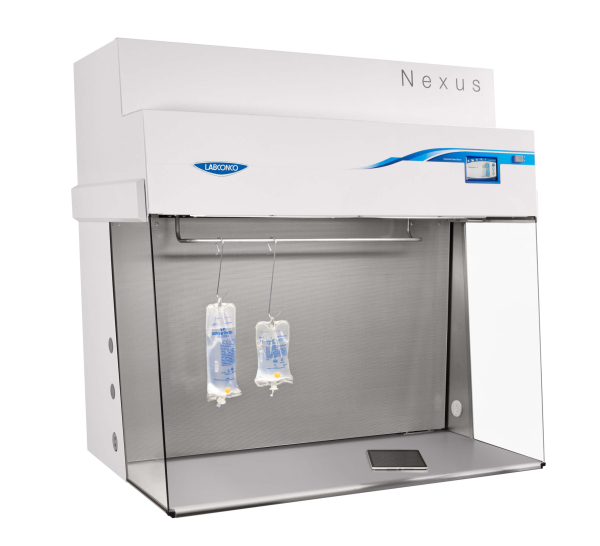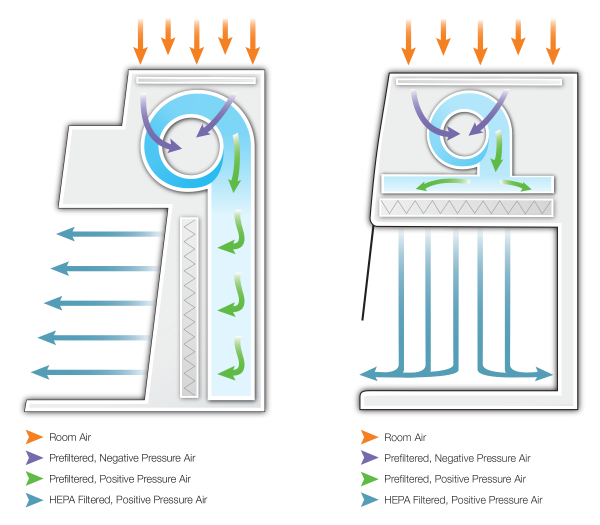Horizontal vs Vertical LAFWs: Which is Best for my Pharmacy?
Laminar airflow workstations (LAFWs) are primary engineering controls (PECs) that provide clean, ISO 5 HEPA filtered work environments for sterile, non-hazardous compounding. Used primarily for preparing sterile, injectable medications that are non-hazardous, LAFWs direct HEPA filtered air over the work area to provide a unidirectional ISO Class 5 work area suitable for compounding of sterile products in accordance with USP <797>.
The benefits of a LAFW are:
1) Product protection
2) ISO Class 5 minimum working environment
3) Spacious, open working area

LAFWs provide a generous and well-lit work surface for maximum product protection and user comfort and come with either horizontal or vertical filtered laminar air flow. The design of a horizontal LAFW pushes air through a HEPA filter at the back wall, then directs the filtered air horizontally over the work surface at a constant speed toward the technician. First air exiting the HEPA filter sweeps through the work area and carries any contaminants away from the critical site of compounded sterile products (CSPs). A vertical LAFW pushes air downward through a HEPA filter which is located at the top of an enclosure. The air is directed downward onto the work surface at a constant speed and exits the unit out the front and rear of the enclosure.

Both configurations offer product protection…so why choose one over the other? It really comes down to what equipment you need to use in the work area.
Historically, the horizontal LAFW has been the go-to for compounding pharmacies. The horizontal airflow design allows for a taller and larger front opening and working area. This design allows for easy access to the work area and free access to IV bags suspended from an IV bar in the upper portion of the ISO 5 work area. One of the key benefits is the absence of a sash, which is an advantage reaching from the worksurface up to an IV bag.
A vertical LAFW, on the other hand, uses a small glass sash across the cabinet front and has an opening for the technician to work through – similar in design to a Class II Biosafety Cabinet used for sterile hazardous compounding such as chemotherapy preparation. The sash of a vertical LAFW ensures that HEPA filtered air bathes the work area from the top down and offers some additional personal protection from aerosols or droplets by way of a physical barrier between the technician and the work they are performing.
This design of a vertical LAFW also provides an airflow advantage over a horizontal LAFWs when placing large equipment such as Total Parenteral Nutrition (TPN) Compounders or IV Verification Systems into the LAFW. Instruments such as TPNs and IV Verification Systems placed into horizontal LAFWs may obstruct first air coming out of the rear-wall HEPA filter before ever reaching the critical site of a CSP. To avoid this problem, a wider LAFW is required so that a technician can work to the left or right of the instrument. However in a vertical LAFW, the downflow air is not obstructed by instruments, making preparation of CSPs in first airflow of the PEC is simple to conduct.
Ultimately the decision of which style of LAFW is appropriate should be determined after considering multiple factors, including user preference, available space in the pharmacy, specific modes of equipment required in the compounding pharmacy.
| chevron_left | ¿Cuánto tiempo llevará liofilizar mis muestras? | Articles | USP update: Enclosure selection guide for the compounding pharmacy | chevron_right |






